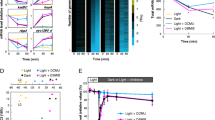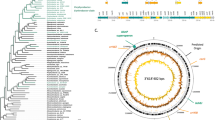Summary
The total RNA in stationary phase cultures of the dinoflagellate,Gonyaulax polyedra, in continuous light showed a well-defined circadian rhythm, as measured by the fluorescence of cells stained with acridine orange. The maximum RNA was found at CT 18 and was followed by a sharp drop in RNA content. The rhythm in RNA content could be phase-shifted by light in the same way as the rhythm in bioluminescence. Ribosomal RNA synthesis, as measured by the incorporation of32P into extracted RNA, was also rhythmic. New RNAs appeared at CT 18, as shown by acrylamide/agarose gel electrophoresis. Three to four hours later these RNAs had disappeared. These findings suggest a role of transcription in the expression of circadian rhythmicity inGonyaulax.
Similar content being viewed by others
Abbreviations
- CT :
-
circadian time, 24 h with 00 as the beginning of light phase
- DTT :
-
dithiothreitol
- EDTA :
-
ethylenediamine tetraacetate
- SDS :
-
sodium dodecyl sulfate
- hnRNA :
-
heterogeneous nuclear RNA
References
Abraham KA, Lillehang JR (1976) Enzymatic cleavage of m7GDP from eucaryotic mRNA. FEBS Lett 71:49–52
Barnett A, Ehret CF, Wille JJ Jr (1971) Testing the chronon theory of circadian time-keeping. In: Menaker M (ed) Biochronometry. Natl Acad Sci, Washington, pp 637–650
Bradley DR, Wolf MK (1959) Aggregation of dyes bound to polyanions. Proc Natl Acad Sci USA 45:944–952
Dörig R, Rensing L (1973) Circadian rhythm of different RNA fractions in rat liver and the effect of cycloheximide. Comp Biochem. Physiol 45B:285–290
Dunlap JC, Taylor W, Hastings JW (1980) The effects of protein synthesis inhibitors on theGonyaulax clock. 1. Phase-shifting effects of cycloheximide. J Comp Physiol 138:1–8
Ehret CF, Trucco E (1967) Molecular models for the circadian clock. I: The chronon concept. J Theor Biol 15:240–262
Geppinger G, Bröking P, Hardeland R (1979) Diurnal rhythmicity of nuclear and cytoplasmic polyadenylated ribonucleic acids and of polyadenylate-dependent polyadenylate polymerase in rat liver. Int J Chronobiol 6:23–30
Gressel J, Berman T, Cohen N (1975) Dinoflagellate ribosomal RNA; an evolutionary relic? J Mol Evol 5:307–313
Guillard RRL, Ryther JH (1962) Studies of marine plankton diatoms. I.Cyclotella nana Hustedt andDetonula confervacea (Cleve) Gran. Can J Microbiol 8:229–239
Hastings JW (1960) Biochemical aspects of rhythms: phase shifting by chemicals. Cold Spring Harbor Symp Quant Biol 25:131–143
Holland MJ, Hager GL, Rutter WJ (1977) Characterization of purified poly(adenylic acid)-containing messenger RNA fromSaccharomyces cerevisiae. Biochemistry 16:8–16
Hutton JR, Wetmur JG (1973) Effect of chemical modification on the rate of renaturation of deoxyribonucleic acid. Deaminated and glyoxalated deoxyribonucleic acid. Biochemistry 12:558–563
Karakashian MW, Hastings JW (1963) The effect of inhibitors of macromolecular synthesis upon the persistent rhythm of luminiscence inGonyaulax. J Gen Physiol 47:1–12
Karakashian MW, Schweiger H-G (1976) Evidence for a cycloheximide-sensitive component in the biological clock ofAcetabularia. Exp Cell Res 98:303–312
Martens CL, Sargent ML (1974) Circadian rhythms of nucleic acid metabolism inNeurospora crassa J Bacteriol 117:1210–1215
McMaster GK, Carmichael GG (1977) Analysis of single and double stranded nucleic acids on polyacrylamide and agarose gels by using glyoxal and acridine orange. Proc Natl Acad Sci USA 74:4835–4838
Rothman BS, Strumwasser F (1976) Phase shifting the circadian rhythm of neuronal activity in the isolatedAplysia eye with puromycin and cycloheximide. J Gen Physiol 68:359–384
Schweiger H-G, Schweiger M (1977) Circadian rhythms in unicellular organisms: an endeavor to explain the molecular mechanism. Int Rev Cytol 51:315–342
Steinhart WL (1971) Diurnal rhythmicity in the template activity of mouse liver chromatin. Biochim. Biophys Acta 228:301–305
Sweeney BM, Hastings JW (1957) Characteristics of the diurnal rhythm of luminescence inGonyaulax polyedra. J Cell Comp Physiol 49:115–128
Traganos T, Darzynkiewicz Z, Sharpless T, Melamed R (1977) Simultaneous staining of ribonucleic and desoxyribonucleic acids in unfixed cells using acridine organe in a flow cytofluorimetric system. J Histochem Cytochem 25:46–56
Vanden Driessche T, Bonotto S (1969) The circadian rhythm in RNA synthesis inAcetabularia mediterranea. Biochem Biophys Acta 179:58–66
Walz B, Sweeney BM (1979) Kinetics of the cycloheximide induced phase changes in the biological clock inGonyaulax. Proc Natl Acad Sci USA 76:6443–6447
Author information
Authors and Affiliations
Rights and permissions
About this article
Cite this article
Walz, B., Walz, A. & Sweeney, B.M. A circadian rhythm in RNA in the dinoflagellate,Gonyaulax polyedra . J Comp Physiol B 151, 207–213 (1983). https://doi.org/10.1007/BF00689920
Accepted:
Issue Date:
DOI: https://doi.org/10.1007/BF00689920




